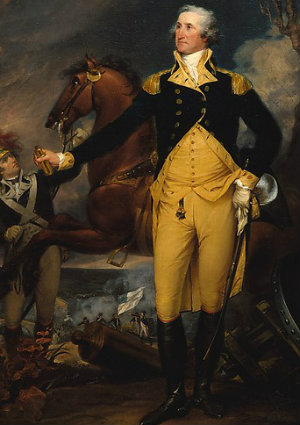Search:: Artists Alphabetically Artists by Country Artists by Century Artists by Movement
John Trumbull
1756-1843
American Neoclassical Painter of the American Revolutionary War
Artistically and Stylistically Influenced by the Following Painters -Benjamin West, John Singleton Copley and John Smibert
Education - graduated from Harvard university and later the Royal Academy in London where he studied under Benjamin West

Artist Biography
John Trumbull's paintings are outstanding examples of the American Neoclassical style in the nineteenth century. His favorite subjects were historically important scenes from the American Revolution as well as historical portraiture. He believed as Wincklemann did that "Color contributes to beauty, but it is not beauty. Color should have a minor part in the consideration of beauty, because it is not but the structure that constitutes its essence."
Description and Origins of the Neoclassic Art MovementThe period is called neoclassical because its artists looked back to the art and culture of classical Greece and Rome. The Neo-Classical movement was centered in Rome, where many painters congregated around the German classical archaeologist and art critic Johann Joachim Wincklemann. Winckelmann gushed about the "noble simplicity and quiet grandeur” of Greek sculpture, which he believed to be the most perfect beauty ever created by human hands, and recommended that artists emulate these classical forms. Neoclassical art is characterized by its classical form and structure, clarity, and to an degree, realism.
More than just an
classical revival, Neo-Classicism was connected to political events of
the time. Neo-Classical artists at first wanted to supplant the
eroticism and frivolity of the Rococo style with a style that was
orderly and serious in character. French Neoclassism painters
emphasis's patriotism, as well as a sense of civility and
honorableness. The movement was particularly connected with the beliefs
of the French Revolution and was seen as anti-aristocratic. The
fantasy-based aristocratic art of the Rococo seemed an insult upon the rights of men
and was vilified by critics and the general public. In an age
of sweeping revolution and transformation Neoclassicism became the art
of change
Principle Artists of the Neoclassical Period
James Barry Irish,
1741-1806
Antonio
Canova Italian,
1757-1822
Jacques-Louis
David French,
1748-1825
Jules
Elie Delaunay French,
1828-1891
Francois
Gerard French,
1770-1837
Antoine-Jean
Gros French, 1771-1835
Jean-Auguste-Dominique
Ingres French,
1780-1867
Angelica
Kauffmann Swiss,
1741-1807
Rembrandt
Peale American,
1778-1860
Bertel
Thorvaldsen Danish,
1770-1844
John
Trumbull American,
1756-1843
Elisabeth
Vigee-Lebrun
French, 1755-1842
Benjamin
West American,
1738-1820
☼☼☼☼☼
Require more facts and information about the painter and the artists of the neoclassical style? Poke around every nook and cranny of the known universe for information this subject. Search Here
© HistoryofPainters.com If you like this page and wish to share it, you are welcome to link to it, with our thanks.